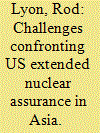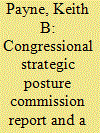| Srl | Item |
| 1 |
ID:
123986


|
|
|
|
|
| Publication |
2013.
|
| Summary/Abstract |
This article aims to explore the credibility of future US extended nuclear assurance in Asia.
Extended nuclear assurance, all too frequently confused with extended nuclear deterrence, faces a daunting series of challenges: a US strategic mainstream fractured on the roles and purposes of nuclear weapons; an Asia where assurance demands are high during a period of strategic uncertainty; and a US theatre- and tactical-range nuclear arsenal much depleted from its heyday. Meanwhile, nuclear latency is growing in Asia as more countries reach the technological level that the US attained in 1945, as nuclear skill sets become more prevalent, and as delivery vehicles appropriate to nuclear weapons become more typical in regional arsenals.
The US now provides extended nuclear assurance to nearly 40 countries worldwide, agreeing to run nuclear risks on behalf of its allies and friends. The bulk of those assurances derive from the NATO alliance, but it is the non-NATO-related assurances - and settings - that seem likely to be the more controversial ones over the next decade or two. Asia is coming into its own at a time when extended nuclear assurance needs reinvigoration as a key ingredient in US strategic policy.
|
|
|
|
|
|
|
|
|
|
|
|
|
|
|
|
| 2 |
ID:
106259


|
|
|
|
|
| Publication |
2011.
|
| Summary/Abstract |
The bipartisan Congressional Strategy Posture Commission offered numerous recommendations to reduce what it labeled "the nuclear danger." The Obama Administration has pursued some of these recommendations via its policy documents, such as the 2010 Nuclear Posture Review, its budgets, and plans. There is reason, however, for several concerns in this regard. These involve the high priority placed on nuclear force reductions at the potential expense of other national goals, including deterrence and assurance; the maintenance of the flexibility and resilience of the U.S. force posture necessary to meet deterrence and assurance requirements now and in the future; continued support for U.S. strategic defensive capabilities given Russian opposition; and apparent interest among some in the Administration to move increasingly toward what has been termed a policy of Minimum Deterrence.
|
|
|
|
|
|
|
|
|
|
|
|
|
|
|
|